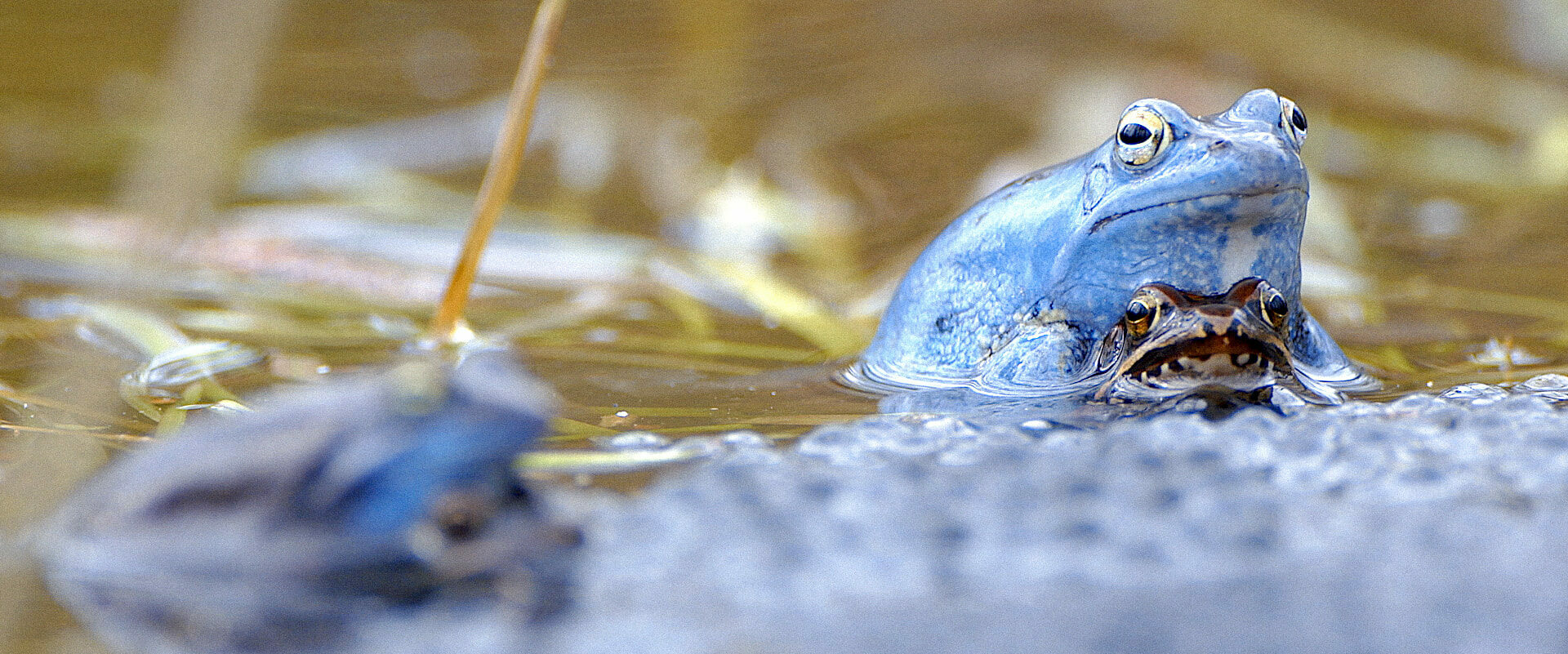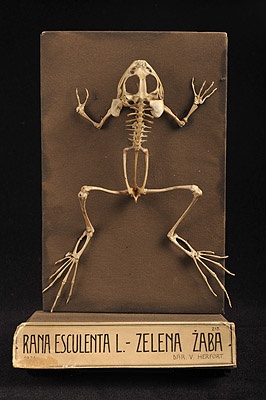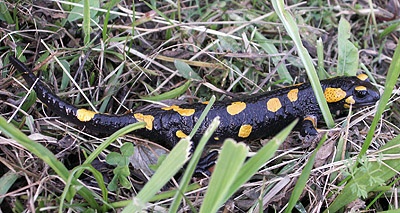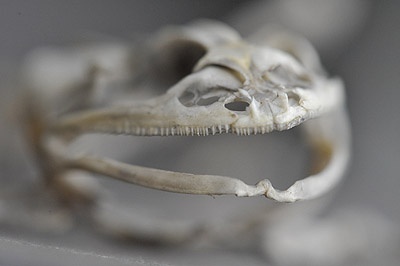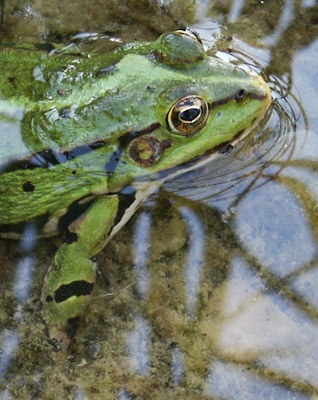Slovenia is inhabited by 19 indigenous amphibian species.
Classification of amphibians living in Slovenia (summed up from the Key to classification of vertebrates of Slovenia, Kryštufek & Janžekovič, 1999):
-
- 1.order (ordo): tailed amphibians (Caudata)
- 1.1.family (familia): acquatic salamanders (Proteidae) with one species – Olm (Proteus anguinus)
- 1.2.family (familia): true salamanders and newts (Salamandridae)
- 1.2.1.genus: newts (Triturus)
- 1.2.2.genus: true salamanders (Salamandra)
- 2.order (ordo): frogs and toads (Anura)
- 2.1.family (familia): true frogs (Hylidae)
- 2.2.family (familia): fire-bellied toads (Bombinatoridae; previously Discoglossidae)
- 2.3.family (familia): true toads (Bufonidae)
- 2.4.family (familia): European spadefoot toads (Pelobatidae)
- 2.5.family (familia): true frogs (Ranidae)
The ancestors of currently living amphibians are fish
Amphibians evolved in the Devonian (Paleozoic) from fish and are the first vertebrates that adapted to life on land. A fossil of an extinct amphibian has been found in Slovenia as well.
Amphibians are vertebrates
Amphibians have 4 developed limbs. Generally, they have 4 toes on the fore feet and 5 toes on the hind feet. The Olms (Proteus anguinus) have 3 toes on the fore feet and 2 toes on the hind feet. The ribs are very short and do not surround the lungs. Amphibians push air into their lungs with their mouths, while gas exchange takes place through their skin, too. Even after metamorphosing, the Olms retain the form of larvae (neoteny) and also have developed external gills in addition to lungs. Tailed amphibians are equipped with developed tails, whereas frogs and toads, also called tailless amphibians, have no caudal vertebrae.
The body of amphibians is covered with bare skin (without scales or hair), which has numerous mucous glands to keep the skin permanently moist. The skin also contains poison glands, which are used by amphibians to defend themselves against bacteria, fungi and predators. The poisons secreted by the amphibians living in our country are not toxic to humans, but only irritate the mucous membranes (eyes, nose, mouth, wounds).
Adult amphibians are predators
Amphibians feed on insects, snails, spiders, and earthworms, thus regulating the abundance of their prey in nature. Those who swear by close-to-nature gardening are pleased to have a toad in their garden.
Amphibians swallow their prey with their eyes
Amphibians are threatened largely by their habitat destruction (draining and filling up of wetlands), water pollution, use of chemical substances (e.g. pesticides), climate change and disconnection of migration routes by roads (amphibians run over by cars). As they are endangered, they are protected. It is forbidden to kill them, poison them and destroy their habitats (Regulation on wild animal species, Reg. l. 46/2004; Red list of endangered reptile species, Official Gazette RS 82/2002).
Frog’s love hug
In frogs and toads, fertilization is external, while in tailed amphibians it is internal. The male frog or toad clings to the female (amplexsus), and as soon she starts releasing the eggs, the male fertilizes them simultaneously. During the courtship dance, the male tailed amphibian releases the spermatophore (gelatinous capsule containing sperm) into the female’s cloaca, enabling fertilization to takes place inside her body. Female newts lay fertilized eggs and wrap them individually in aquatic plants. Salamanders are viviparous – the eggs develop in the female’s body, then tadpoles are hatched (vivipary).
Amphibian eggs with gelatinous coating are deposited in the water – one by one, in lumps, clumps, strings or ribbons. The species can thus be identified also the shape of the spawn.
Frogs call mostly in mating season. You can learn distinguish frogs by their croaking with the aid of the CD Slovenske žabe (Slovenian Frogs and Toads).
In the Fire Salamander (Salamandra salamandra), the eggs develop in the female’s body to the larval stage and are then hatched in the water. Larvae breathe in water with gills and gradually transform into adult amphibians. In the Alpine Salamander (Salamandra atra), the eggs also develop in the female’s body, except that the young are born after the metamorphosis has already been completed.
Amphibian conservation
Amphibians feed on insects, snails, spiders, and earthworms, thus regulating the abundance of their prey in nature. Those who swear by close-to-nature gardening are pleased to have a toad in their garden.
Amphibians are threatened largely by their habitat destruction (draining and filling up of wetlands), water pollution, use of chemical substances (e.g. pesticides), climate change and disconnection of migration routes by roads (amphibians run over by cars). As they are endangered, they are protected. It is forbidden to kill them, poison them and destroy their habitats (Regulation on wild animal species, Reg. l. 46/2004; Red list of endangered reptile species, Official Gazette RS 82/2002).
Experts in Europe and around the world have recently detected the problem of amphibian extinction due to a viral disease caused by ranaviruses and fungal disease called chytridiomycosis. The latter is a disease caused by the fungus Batrachochytrium dendrobatidis from the group Chytridiomycota. Owing to this fungus, amphibian populations around the globe are in major decline. In adult amphibians (Anura and Caudata), the fungus attacks the keratin layer of the skin, while in tadpoles (Anura) it affects the mouthparts (Garner et al., 2005). The fungus has caused death and decline of amphibian populations in Spain, Germany, Australia, New Zealand, USA, Central America, South America (Hyatt et al., 2007), with individuals suffering from this disease also confirmed in Portugal, Great Britain, Italy and Switzerland (Garner et al., 2005).
Ranaviruses (Iridoviridae family, Ranavirus genus) constitute a group of viruses that infect fish, amphibians and reptiles. The commonest symptom of Ranavirus infection in amphibians is a high number of dead specimens in a short period of time. Signs of infection can be red skin (subcutaneous bleeding), limb necrosis and lethargy, although these signs are not necessarily obvious or revealed. The virus causes high mortality among amphibians. The disease most frequently develops during the summer, since the virus is most virulent at temperatures above 25°C.
The photo displays a male (blue) and a female Moor Frog (Rana arvalis) during mating. In the mating season, the male’s skin turns blue. This frog belongs to the brown frogs and lays its eggs in clusters (spawns). Photo: A. Petrinjak
Male (smaller one above) and female (larger one below) Common Toads (Bufo bufo) during mating. Next to them, the Common Toad’s string-shaped spawn can be seen. Photo: T. Trilar
Male (smaller one above) and female (larger one below) Common Toads (Bufo bufo) during mating. Next to them, the Common Toad’s string-shaped spawn can be seen. Photo: T. Trilar
Interesting facts:
The oldest amphibian specimen in the Slovenian Museum of Natural History’s study collection is a Common Toad (Bufo bufo) from the vicinity of Ljubljana, dating back to 1896. The Museum also presents the only European cave amphibian. In the cave diorama, a plastic specimen of the White Olm was made. The visitors can watch a short film about the Olm’s two subspecies, the White Olm (Proteus anguinus anguinus Laurenti 1768) and the Black Olm (Proteus anguinus parkelj Sket & Arnzten 1994), as well as some other interesting subterranean fauna.
Listen to a few sounds from the CD Slovenian Frogs.
Some interesting features about the Olm (Proteus anguinus)
Literature:
- Aljančič Marko (ur.),1993. Proteus: skrivnostni vladar kraške teme. Ljubljana, Vitrum.
- Poboljšaj Katja, 2003. Dvoživke (Amphibia). V: Živalstvo Slovenije, ur. Sket Boris in drugi. Ljubljana, Tehniška založba Slovenije:505 – 511
- Veenvliet Paul in Veenvliet Kus Jana, 2008. Dvoživke Slovenije: priročnik za določanje. Grahovo, Symbiosis – Zavod za naravovarstveno raziskovanje in izobraževanje: 96 str.
- Vogrin Nuša, 1999. Razred: dvoživke, Amphibia. V: Ključ za določanje vretenčarjev Slovenije, ur. Kryštufek Boris in Janžekovič Franc. Ljubljana, DZS: 284 – 305


